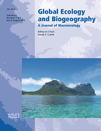Large trees whose diameter at breast height (dbh) is greater than or equal to 70 cm store large amounts of biomass. Several studies suggest that large trees may be vulnerable to changing climate, potentially leading to declining forest biomass.Prof. Ferry Slik of Xishuangbanna Tropical Botanical Garden (XTBG) and his many international colleagues conducted a study with two aims: 1) to evaluate how much of the global variation in aboveground biomass can be explained by the density of large trees; 2) to identify the potential drivers of observed differences in the density of large trees and variation in aboveground biomass across the tropics.
The researchers used a pan-tropical tree inventory data set from 120 old-growth lowland tropical moist forest locations (33 in South America, 45 in Africa, 42 in Southeast Asia) containing 192,308 stems (≥ 10 cm stem diameter) to address the above-mentioned topics at continental and pan-tropical scales.
Aboveground biomass (AGB) was calculated for 120 intact lowland moist forest locations. Linear regression was used to calculate variation in AGB explained by the density of large trees. Akaike information criterion weights (AICc-wi) were used to calculate averaged correlation coefficients for all possible multiple regression models between AGB/density of large trees and environmental and species trait variables correcting for spatial autocorrelation.
The study found that big trees (d.b.h. ≥ 70 cm) were functioned as drivers of variation in aboveground biomass. Pan-tropical variation in density of large trees and AGB was associated with soil coarseness (negative), soil fertility (positive), community wood density (positive) and dominance of wind dispersed species (positive), temperature in the coldest month (negative), temperature in the warmest month (negative) and rainfall in the wettest month (positive), but results were not always consistent among continents.
The researchers concluded that density of large trees and aboveground biomass were significantly associated with climatic variables, indicating that climate change would affect tropical forest biomass storage. Species trait composition would interact with the future biomass changes as they were also affected by a warmer climate. Given the importance of large trees for variation in aboveground biomass across the tropics, and their sensitivity to climate change, the researchers emphasized the need for in-depth analyses of the community dynamics of large trees.
The study entitled “Large trees drive forest aboveground biomass variation in moist lowland forests across the tropics” has been published online in Global Ecology and Biogeography, a journal ranking first in GEOGRAPHY, PHYSICAL and 8th in Ecology in the Journal Citation Reports (JCR).


